
|
An edited version of this story appeared in two parts in the "Weekend Argus" (a newspaper published in Cape Town, South Africa) - on Saturday 17 October 2009 and Saturday 12 December 2009. | |
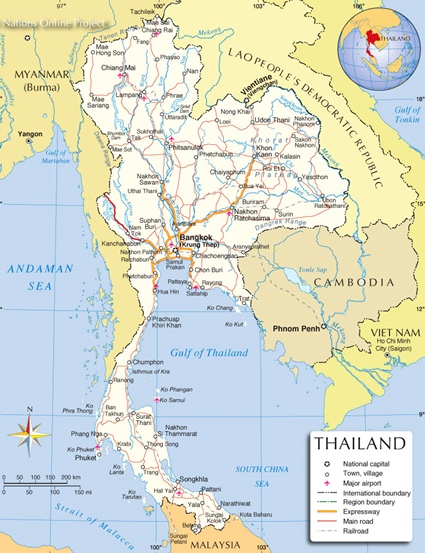
Map © Nations Online Project (info) | |
|
South-East Asia Cambodia Laos Malaysia Myanmar (Burma) Singapore Thailand (Siam) Vietnam |
Phnom Penh Vientiane Kuala Lumpur Yangon (Rangoon) Singapore Krung Thep (Bangkok) Hanoi |
If you enjoyed reading this, please send me an email. All correspondence is appreciated!
[Friday 16 June 2006 : Cape Town, South Africa] Malaysian Airlines picked us up in Cape Town and delivered us to Kuala Lumpur International Airport (KLIA), one of the better places in the world to be if you have to sit through a long layover (as we did). There is a fully automated train that runs between the domestic and international terminals, and we rode it backwards and forwards once or twice to while away the time while waiting for our connecting flight to Bangkok. The airport was familiar territory for me - I'd been in Kuala Lumpur before when I'd visited Australia in 2001.
[Saturday 17 June : Bangkok, Thailand] A middle of the night departure from Kuala Lumpur at least meant we arrived in Bangkok relatively early, albeit without much sleep. Customs and Immigration was swift and efficient - Thailand understands the value of tourism and has visa-free entry for citizens of most countries, including South Africa ... so before we knew it we were walking out into the scrum of airport touts, agents and scam artists. Luckily we didn't have to dicker with a taxi driver or figure out the bus system from the airport because we had managed to get an air ticket-hotel package deal (including three nights' accommodation in Bangkok and free airport transfers) that was cheaper than the flight on its own; we simply looked for somebody holding a sign with our hotel's name on it, then sat back in air-conditioned comfort as we were driven through Bangkok's chaotic traffic to the hotel [Aside : Bangkok was officially renamed to Krung Thep Maha Nakhon (or simply Krung Thep) in 1972, but even today very few people use this name].
The hotel proved to be a cut (actually several cuts) above the kind of place we would normally have stayed in - it was a massive multi-storey complex of restaurants, bars, swimming pools and luxurious rooms. No complaints from us though; our three nights here were essentially free. But with little time to waste we didn't linger in our plush room and headed straight out again to explore. Bangkok is a huge, sprawling place, with traffic that words cannot describe. Any faint idea that we might rent a car was very quickly dispelled ... It is also relentlessly hot and humid and the sidewalks are crowded with pedestrians, so getting around is slow and tiring.
We arranged a 3-day trip to Kanchanaburi at a shady back street travel agent and eventually found our way to Khao San Road, probably the most infamous street in South-East Asia and a mecca for scam artists, Thai "ladyboys", drug pushers, addicts, penniless backpackers and all manner of people on the run or simply trying to disappear from normal society. We checked out a few sleazy hotels and found a reasonable place which we booked for our return from Kanchanaburi (our package deal only gave us three free nights at the smart hotel we'd already checked into, two of them immediately we arrived and the third on the night before we flew out of Thailand).
Supper was some tasteless sludge at a fast food place, after which we had a long, relaxing swim in the hotel's fourth floor swimming pool.
[Sunday 18 June : Bangkok, Thailand] Much of Bangkok is chaotic, but the new SkyTrain elevated railway is far from it - it is squeaky clean, slick and efficient, and we used it to ride above the traffic and get to the Chao Phraya River. This broad and muddy watercourse winds its way through central Bangkok and is much favoured as a means of transport - fast and frequent passenger boats run up and down the river, stopping at stations on both sides and allowing people to get around Bangkok without having to deal with the frenetic traffic on the crowded streets. The river goes past many of the city's grand buildings, such as the Royal Palace, the National Museum and the Temple of Dawn, so you can do some sight-seeing while being ferried to your destination.
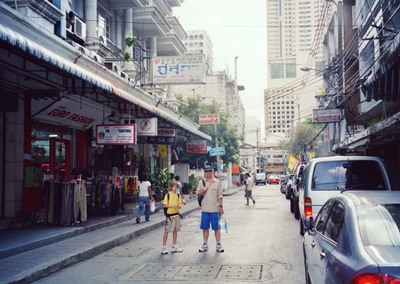
We climbed onto a boat going in the direction of the Grand Palace. It was crowded, but we wanted to stand at the rail and look out anyway. A guy with a metal box pushed his way through and we gathered we had to pay him - he took our cash, gave us three tickets plus change and moved on. I followed the route of the boat on my map, gazing out at the riverside view of Bangkok as we puttered up the river - warehouses, factories belching smoke, restaurants spewing who knows what pollution into the water and, occasionally, a stately building. We got off the boat at the station nearest to the Grand Palace and walked a couple of blocks in the rain.
The Grand Palace isn't one building but rather an entire complex of gardens, temples, courtyards, pavilions and offices. It was constructed in 1782 as the official residence of the king of Siam and remains in use by the Royal Family to this day [Aside : Siam was renamed to Thailand in 1939, reverted back to Siam in 1946 and finally changed back again in 1948]. In fact, until Siam/Thailand became a democracy in 1932 the Grand Palace was also the seat of government. These days the palace complex is partially open to the public and is one of the most popular tourist attractions in Thailand, but it is still used for occasional state functions and contains many offices and working spaces.
Scott and I had to hire long pants to get inside - no shorts are allowed as all visitors have to have their legs and shoulders covered. We marvelled at the solid gold Buddha in the palace and walked for what seemed like kilometres through the palace grounds before the heat drove us into a nearby restaurant for lunch.
[Monday 19 June : Kanchanaburi, Thailand] We left Bangkok early, taking a minibus north-west to Kanchanaburi, a hair-raising trip of two and a half hours. The driver seemed to be a homicidal (or at least suicidal) maniac, and at times for no reason that we could see he simply put his foot flat on the accelerator until we were going at an insane speed, the engine roaring in protest. Then just as suddenly he would let the speed slacken off. We, and the other white-faced Westerners in the back, hung onto our seats and watched the blur of movement through the windows in goggle-eyed terror as the bus howled past other cars on the road. "Why didn't we take the train to Kanchanaburi?" was the thought that kept popping into my head.
But, incredibly, we arrived in Kanchanaburi without mishap, not even any passenger instances of TILBS (terror induced loose bowel syndrome). When I stepped off the bus onto terra firma I felt rather like a solo round-the-world sailor reaching a safe port after days of stormy weather ... but we were alive, the weather was mild, the River Kwai was sparkling in the sun and the bus had dropped us right at the front door of our guest house so we had no cause to complain. Indeed, the Pong Penh Guest House (where we checked in for the next two nights), was a most relaxed and laid-back place; despite its rather insalubrious name and proximity to the River Kwai, it was clean and did NOT stink. Our 3-bed bungalow was spacious and the open-air terrace looking out over the river where meals were served was a great place to unwind after the stresses of Bangkok.
After dumping our gear we went for a ride on a long-tail boat on the River Kwai [Aside : Long-tail boats are common across South-East Asia - this is a type of craft with an engine mounted inboard, on top of the hull, with a propeller at the end of a long pole that the driver raises or lowers into the water. The pole can swivel left to right so it is used to steer the boat as well as provide power. It is a very simple and practical design and you see these boats everywhere, from small canoes that can take only one or two people to massive barge-like passenger ferries].
We got off the boats at a spot some distance down-river from Kanchanaburi and went for a long hike to Kao Poon cave, a series of underground caverns containing several Buddhas of varying sizes - a very hot and sweaty experience. On the way back up-river we were dropped off near Chungkai Cemetery, a sombre place maintained by the Commonwealth War Graves commission. It contains the graves of thousands of Allied prisoners-of-war who died while being forced by the Japanese to build the "Death Railway" between Thailand and Burma during World War II. Everything is absolutely immaculate, with row upon row of perfectly maintained graves separated by neatly trimmed grass. The cemetery is a sad and silent place, the names and (often very young) ages of the soldiers on each headstone bearing mute testimony to the horrors of war and the inhumanity of which the human race seems capable.
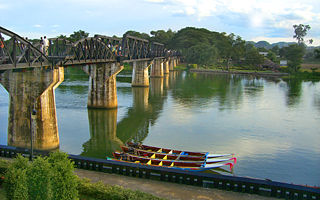

Back in Kanchanaburi we walked over the legendary River Kwai bridge, the same bridge that was built by World War II prisoners and is still in use today; it is pock-marked with bullet holes and bomb damage. The original wooden trestle bridge that was first built has long since been destroyed - that bridge, which was the basis of David Lean's classic 1957 film The Bridge on the River Kwai, was in any case only ever intended to be temporary. The second bridge, a more permanent steel and concrete structure, is the one that is still there. Six scheduled trains a day travel over the River Kwai bridge between Kanchanaburi and the Thai railway terminus at Nam Tok, not far from the Myanmar border. Near Nam Tok is "Hellfire Pass", a ravine through which the railway used to run and which is now a popular hiking trail - you actually walk on the old trackbed. The railway tracks from Nam Tok westwards over the border into Myanmar (Burma) were lifted several years ago, so it is no longer possible to take a train from Thailand to Myanmar.
Update 1 : In May 2012 the Myanmar Minister of Railways announced that a feasibility study would be carried out later in the year to determine the viability of re-opening the death railway on the Myanmar side of the border. The tracks in Myanmar that were not destroyed by Allied aircraft during World War II have been reclaimed by the jungle, so extensive rehabilitation in very difficult terrain will be needed. The intention is to rebuild a 105 kilometre stretch of track from Thanbyuzayat in Myanmar to the Three Pagodas Pass on the Thai border. However, that would still leave a stretch of about 164 kilometres from the Three Pagodas Pass to the existing Thai railway terminus at Nam Tok to be built, and there has been no suggestion from Thailand Railways that they are prepared to fund this. The biggest problem is that the Vajiralongkorn Dam in Thailand, built in 1984, has covered the route beyond Nam Tok under many metres of water.
Update 2 : I have no idea if the survey mentioned above was ever completed, but as of May 2016 there is no indication that there are any concrete plans to rebuild the Death Railway. These grandiose schemes have a way of quietly disappearing once the highly-paid consultants have done their work and delivered piles of documents and pie-in-the-sky plans.
Update 3 : It appears as if the latest plan is to convert the original Death Railway route in Myanmar into a ROAD.
Later that afternoon we took a minibus out to Taweechai Elephant Camp and signed on for a ride on their tame elephants. Karen and Scott climbed onto one elephant, I got on another and together with several other similarly-mounted tourists off we went into the forest. Riding elephants may look like a breeze (I mean, how difficult can it be?), but it is actually quite uncomfortable. The wooden platform on the elephant's back on which I was sitting rocked and swayed alarmingly as the huge pachyderm plodded up and down jungle slopes, pausing every now and then to rip off some juicy looking foliage with his trunk for a quick snack. I had to hang on tightly, and every so often the iron bar across the back of the platform dug painfully into my back.
So it came as somewhat of a relief when we arrived at the River Kwai where there was level ground rather than an uneven jungle track. There were several people in our group, and it happened at that point that I was in front, so I was quite bemused when the elephant simply walked into the river without any hesitation. I looked back and saw the other elephants also entering the water, but I was a bit slow on the uptake and still hadn't figured out what was next. We were in quite deep water, about head-height for an adult, and when I glanced over at the mahouts (elephant handlers) on the river bank I saw that they were laughing. My elephant dipped his trunk into the water and I suddenly realized that the joke was on us, the tourists - the elephant tipped his trunk over his head and I was instantly drenched by a ferocious blast of water. Managing to hold on with difficulty, I looked around and saw the others receiving similar treatment. These trunk sprays were so powerful that a few people were actually blasted off their elephant's back and into the water. Ten minutes later a bunch of soaked but grinning farangs (foreigners) were deposited on the river bank and the mahouts took the elephants away.
Nearby was a village of the Karen hill tribe, where we showered and tucked into an absolutely delicious meal while sitting at a long table under a palm-thatched canopy. I learned that there's nothing quite like being sprayed with water while sitting on top of an elephant to work up an appetite.
| The Death Railway, Kanchanaburi   |
 |
I should point out that during the elephant ride and afterwards I watched the mahouts closely and was relieved to see that they did not seem to be mistreating the elephants ... although what happens back at the camp when the tourists are gone is impossible to say.
[Tuesday 20 June : Kanchanaburi, Thailand] Karen and Scott went on a long-tail boat to an area of floating markets (shops on boats) while I took a slow stroll through Kanchanaburi. I visited the JEATH Museum and the Thailand-Burma Railway Centre, both of which are moving and sombre memorials to the thousands of Allied prisoners-of-war (POWs) who died at the hands of their Japanese captors during the construction of the "Death Railway" [Aside : The acronym JEATH stands for the primary nationalities involved in the building of the railway: Japan, England, Australia, America, Thailand and Holland]. The POWs had to work in extreme conditions with very little food, no medical attention and endured torture and punishment from the brutal Japanese guards. It is estimated that as many as 15 000 POWs and over 100 000 conscripted Asian workers perished while the railway was being built. The Japanese have their own war memorial near the River Kwai bridge, but it was being renovated and could not be seen when we were there.
In January 2016 the Myanmar government opened its own museum commemorating the horrors of the Death Railway; it is in the town of Thanbyuzayat, the western terminus of the line.
In the afternoon we visited Tiger Temple just out of town. This is a sanctuary for tigers that have been rescued or reared in captivity - you can sit next to the tigers and stroke them, which is pretty scary at first because they are HUGE. But you very quickly realize that the tigers just lie there and hardly move, which seemed unnatural to me ... how do you arrange for a dozen fully grown, top of the food chain predators to lie around in a completely docile fashion while crowds of weak and feeble prey (ie. humans) walk among them and stroke them? The tigers must surely have been drugged - how else could they be sure that one wouldn't eventually attack a tourist? Tiger Temple is open every day, so thousands and thousands of people are walking through and interacting with the tigers without mishap. That seemed utterly impossible to me.
So we definitely felt that there was a significant element of exploitation at Tiger Temple. Apart from almost certainly being sedated, the tigers are chained up in a mercilessly hot, sun-blasted rock defile with no shade at all. The well-being of the tigers seemed secondary to the ultimate purpose of fleecing tourists. The centre was run by Buddhist monks but several Western volunteers were also working there, well meaning bunny-hugger types who cleaned cages, carried straw and did whatever dirty work was necessary in return for board and lodging. So not only were the tigers being exploited for financial gain, but the people running Tiger Temple had even managed to persuade foreigners to help them keep the place going for free! All in all this is not a place I would recommend, visit again or support in any way. In fact, if anybody reading this is contemplating visiting Tiger Temple, PLEASE DON'T!
| Bangkok | 0 km |
| Ban Pong (Nong Pladuk) | 64 km |
| Kanchanaburi | 133 km |
| River Kwai | 138 km |
| Nam Tok | 210 km |
| Konyu Cutting (Hellfire Pass) | 228 km |
| Three Pagodas Pass | 374 km |
| Thanbyuzayat (Burma) | 479 km |
| Rangoon (Burma) | 824 km |
In May 2016, after years of complaints from NGOs and animal rights activists, the Thai government finally closed Tiger Temple. All 137 tigers at the facility were removed and relocated to other wildlife reserves.
Back in Kanchanaburi we relaxed on the open-air terrace at Pong Penh Guest House and tucked into another outstanding Thai food supper. I really am enjoying the food in Asia - you never seem to have that heavy feeling in your stomach that you get with some rich Western meals. Food in Thailand is fresh and light, stir-fried quickly in a small amount of very hot oil. Delicious.
[Wednesday 21 June : Bangkok, Thailand] On our last day in Kanchanaburi we visited Erawan National Park, a 550 square-kilometre nature reserve named after the three-headed white elephant of Hindu mythology (the erawan). The main attraction of the park is the Erawan Waterfall, a series of seven "tiered" waterfalls that are incredibly beautiful. We walked up the trail to the top of the falls, swimming several times in the clear, cool water on the way up. The trail through the thick jungle is quite confusing and we got lost once or twice on the way down, but we managed to blunder our way out eventually. There are apparently four caves in the park as well, but we didn't have time to look for them.
After an excellent lunch of Phad Thai at a restaurant in Erawan National Park we walked along one of the oldest sections of the "Death Railway." At this point the tracks run alongside the River Kwai, next to a cliff, on a narrow ledge gouged out of the cliff face by World War II prisoners using nothing but picks and shovels. The rails rest on top of rough and uneven wooden beams embedded in the rock. Incredibly, these tracks are still used by trains today, little changed from when they were laid by prisoners more than sixty years ago!
We waited at a nondescript station in the jungle for the next train, then climbed aboard and headed back to Kanchanaburi. It was exhilarating looking out of the window - the river was on one side, a cliff on the other and the train twisted and turned as it followed the contours of the mountain. We clattered over a series of wooden viaducts (also built by prisoners of war) before veering away from the river. The train was full of young school children going home, all wearing spotless uniforms and laughing and shrieking. Every now and then the train would stop at a siding in the jungle, several children would climb off and disappear into the thick forest on either side. I have no hesitation in putting this trip on my Best Train Trips in the World list.
That evening we took a much more sedate bus from Kanchanaburi back to Bangkok, getting there in the dark. We were dropped off in Khao San Road (backpacker central), but luckily we were familiar with the area and checked into the hotel we'd scouted out three days before. Unfortunately the inside of the hotel, and our room, did not match the rather pleasant appearance of the hotel's lobby - bare concrete walls, doorways so low you had to duck your head to enter and very sparse furnishings. I had to kneel to get my chest under the shower. Welcome to Khao San Road, budget backpacker HQ in South-East Asia.
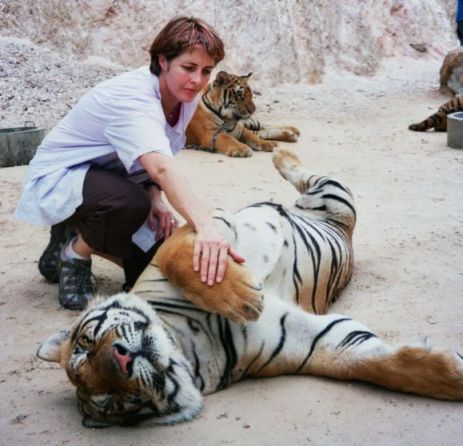
[Thursday 22 June : Bangkok, Thailand] Breakfast was included at our hotel, so after a few frenetic days of travelling it was very pleasant to relax and eat a leisurely meal without rushing. After that we arranged our onward travel from Bangkok - there was a computer connected to the internet in the lobby of the hotel, and we used it to research and book flights to Phnom Penh in Cambodia on Air Asia (a budget airline operating out of Thailand that only sells tickets online). We also worked out our plans for going up north to Chiang Mai and back south again to one of the islands off Thailand's east coast.
Suitably booked, planned and organized (which we should have done BEFORE we arrived, but didn't), we ventured out on foot with maps in hand. By now we'd realized that any Westerner walking around Bangkok holding a map is fair game for the legions of scam artists that prowl the streets, so when we were set upon by a guy who asked where we were going I was ready for him.
"Wat Pho," I said. "And we know how to get there."
The guy didn't miss a beat. "No, it's closed now," he replied, pointing at his watch. "The monks are eating lunch. But I know a much better place. It's not far, I can take you there, just follow me."
"No thanks, we'll take our chances with Wat Pho."
But the guy was insistent and almost tried to pull us down a side street. "My tuk tuk is parked there, come with me."
"No," I replied firmly and walked on. He walked alongside, haranguing us, but we simply ignored him and pretty soon he gave up and wandered off looking for other, more compliant victims.
Of course, when we got to Wat Pho it was NOT closed - it is open all day, every day, and never closes for lunch. Wat Pho (officially named Wat Phra Chetuphon Wimon Mangkhalaram Rajwaramahawihan but generally referred to as the Temple of the Reclining Buddha) is a Buddhist temple complex of major importance in Thailand. It is one of the oldest temples in Bangkok and has been associated with the royal family since the days of King Rama I, who ordered the construction of the Grand Palace near Wat Pho in 1782 [Aside : We visited the Grand Palace four days earlier, on 18 June]. Wat Pho is most well known for the huge reclining buddha inside - it is no less than 46 metres long (but lying on its side, not upright) and entirely covered with gold leaf. Even though it is reclining the statue is still 15 metres high! Each foot is 5 metres long. We walked round it with a sense of awe, then explored some of the many other buildings and gardens in the temple complex.
After that we took a long and rambling walk through Bangkok, via the shambles and chaos of Chinatown (fried cockroaches for supper, anybody?) and then on to Hualamphong train station, Bangkok's main railway terminus. We were planning to take a train to Ayutthaya the next day so we wanted to check the schedules and find out the procedure for getting tickets. Turns out there are frequent trains to Ayutthaya and because it's so close to Bangkok there was no need to buy tickets in advance. Supper that night was a delicious meal of Thai food at one of the many restaurants in Khao San Road.
[Friday 23 June : Ayutthaya, Thailand] We checked out of our Bangkok hotel after breakfast then strolled to the nearest water bus station on the river. From there we took a boat down river to Hualamphong Train Station. We bought tickets on the next train to Ayutthaya and went to find the right platform but instead found confusion and chaos. Crowds of people were milling around and running from one platform to another but there were no trains in sight. Incomprehensible announcements in Thai blared forth from loudspeakers; however, not even the locals around us seemed to understand what was being said or know what was going on. We stood on the platform indecisively, wondering what to do.

A Japanese tourist standing nearby tried to explain what was happening, but he could speak no English and our Japanese was limited to a single word (konnichiwa, which means "hello") so our attempted communication was ineffective to say the least. In desperation this chap resorted to sign language and made train-like movements with his hands, which we interpreted as meaning there had been a train crash or derailment somewhere up the line. After some time a whole crowd of people surged off towards another platform and our Japanese friend picked up his bag to follow them. "Ayutthaya?" I asked him hopefully.
He smiled broadly and nodded. "Ayutthaya," and pointed towards the crowd.
That seemed pretty clear so we also followed the people to another platform, where we found a train parked and ready to depart. In the rush we had lost our Japanese friend, but a Thai waiting to get on the train confirmed that this was indeed the next train to Ayutthaya. Relieved, we climbed aboard and a minute later the doors slammed shut and the train chugged out of the station. The train only had hard wooden bench seats and no air-conditioning, but it was fast and in any case we didn't have very far to go - Ayutthaya is only about 70 kilometres north of Bangkok, in the valley of the Chao Phraya River (the same river that runs through the middle of Bangkok).
In fact, the city of Ayutthaya is on an island, with the river to the east of town and the train station next to the river but on the other side. To get across the river to Ayutthaya involves either a trip on the small ferry that leaves from the bottom of the street leading to the train station or a walk down river to a bridge. When we got off the train we hadn't quite worked these options out, so we elected to walk down to the bridge; it wasn't far but the heat was brutal and by the time we'd climbed up the pedestrian steps and down the other side we were all gasping and soaked with perspiration. Our guide book mentioned a very nice guest house called Bann Kun Phra next to the river not far from the bridge, so we simply walked back up river after crossing the bridge and kept an eye out. We found the place almost directly opposite the train station; it was an old house made entirely of teak and was wonderfully cool inside. Three people is often an awkward number at hotels, but this guest house had a very nice 4-bed room which was perfect and we took it for the next two nights without negotiation.
Bann Kun Phra was indeed an excellent place to stay. Our room was spacious and comfortable (despite the garish red curtains and bedspreads) and the main part of the guest house had a very atmospheric shaded terrace looking out over the slowly-moving waters of the Chao Phraya River. It was also a short walk into town and only a few metres down river from the ferry across to the train station.
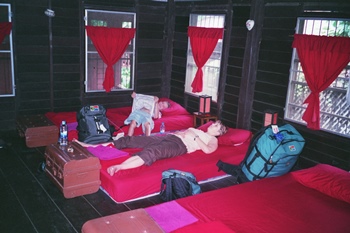

The walk from the train station, although not far, had taken its toll on us; it was relentlessly, mind-numbingly hot. So we rested up before heading out again to explore; unfortunately it was no cooler when we went out in the afternoon. But we only had a couple of days in Ayutthaya and couldn't waste it sitting on Bann Kun Phra's shady riverside terrace, pleasant though that was ... we lashed on sun cream, donned hats, filled our water bottles and headed into town.
Ayutthaya is full of ancient ruins from the days when the city was the capital of a powerful kingdom that ruled huge tracts of modern-day Thailand, Cambodia and Myanmar. This "golden age" lasted from 1350 until 1767, when the city was overrun and sacked by the invading Burmese army. The Burmese burned much of the city and destroyed almost all of Ayutthaya's artworks, treasures, literature and the archives housing its historic records. The city never recovered, despite the Burmese themselves withdrawing shortly afterwards in order to fight a much bigger foe - China.
These days Ayutthaya is a quiet backwater, the shattered ruins of its past glories slowly mouldering in the tropical heat. The entire city is one large open-air museum, the Ayutthaya Historical Park, containing palaces, Buddhist temples, monasteries and statues. There's something interesting to see on almost every street corner. Perhaps the most unusual sight is a Buddha in the grounds of Wat Phra that is slowly being engulfed by the tentacle-like roots of a massive tree - all that remains to be seen is the Buddha's head, mashed between thick roots on either side.
But the baking heat did not let up, and after a couple of hours of walking between the various sights we were starting to feel sick. Close to despair, with no shade in sight and some distance to go to get back to the guest house, we simply went into the first restaurant we saw, not so much for the food but for shade. We ate a late lunch, glad to be out of the sun, and waited inside until the hottest part of the day had passed before venturing out again. However, we quickly discovered what happens after such heat in the tropics - about half way back to our guest house the heavens opened and rain fell with such force that we were completely drenched within seconds. It didn't stop quickly either, so we ran back and stayed indoors that evening as the rain thrashed down onto the roof with such a clamour that talking was difficult.
[Saturday 24 June : Ayutthaya, Thailand] Our experience on our first day in Ayutthaya had taught us that attempting to explore this spread-out city on foot in the severe heat is madness. Luckily there was an alternative - we'd spotted a couple of shops on the road leading from the river to the train station that rented out bicycles. So we walked a few metres up river to the ferry dock, rode across the river and rented three rather ramshackle bicycles from the first place we saw. None of us felt like riding back across the river via the road bridge, so we wheeled the bikes down to the ferry and negotiated with the boat man. Luckily there weren't queues of people at that point and he allowed us to take our bikes across on the ferry; it was a bit awkward getting them on and off the boat but it saved us quite a bit of pedalling in the heat (the "ferry" is just a small boat with room for perhaps a dozen passengers; it conveys a constant stream of people across the river in both directions. The crossing takes about a minute and costs the princely sum of two Bahts (40 SA cents) per person).
I wouldn't dream of suggesting that anybody try this in the insane and congested traffic of Bangkok, but Ayutthaya is perfect for cycling - the roads are wide, traffic is sparse (by Thai standards) and there are no hills to speak of. We had a very enjoyable day riding around and criss-crossed the city from one end to the other. We saw loads of old ruins as well as one impressive structure that managed to survive the destructive Burmese invasion - the immense reclining Buddha in the grounds of Wat Lokayasutharam. Built in the 16'th or 17'th centuries (nobody seems sure exactly when), this buddha is 42 metres long and 8 metres high and lies on its side facing west. It was quite weathered from centuries of sun and rain but work was underway to restore it.
Elsewhere on our ramblings round Ayutthaya we found elephants waiting to give rides to tourists. Unfortunately they looked extremely unhappy and badly treated, a situation which I fear is all too common amongst tame elephants across the whole of Asia ...
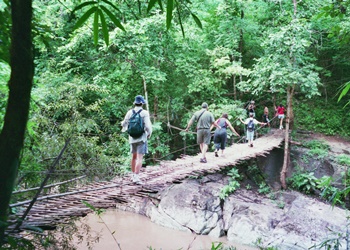
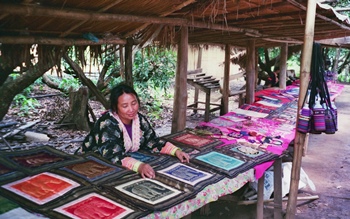
At midday we came across a restaurant on a small island in the river, accessible via a wooden walkway. It was a rustic outdoors place, with tables under an aluminium awning and looked wonderfully cool and inviting. We parked our bikes next to the walkway, strolled across and sat down with relief. Lunch was simple and delicious, and cost the ridiculous sum of ten Bahts each (about two SA Rands). None of us drink fizzy drinks any more, but the heat and humidity was such that we were driven by desperation to have a Pepsi Cola each ... and my body must have needed it, because the sugary chemical-laden syrup went down in one gulp.
Later that afternoon we returned the bikes to the shop near the train station. This time we rode down to the bridge and crossed the river that way rather than via the ferry, then had a long and relaxed supper on the shady terrace at our guest house.
[Sunday 25 June : Chiang Mai, Thailand] After an early breakfast at our guest house we humped our gear across the river on the tiny commuter ferry and caught a train north to Chiang Mai, a ten hour trip in air-conditioned comfort. Meals were served to us at our seats just like on a plane. The countryside in the south is flat and boring, mostly rice paddies, but north of the town of Uttaradit it consists of deep cuttings, soaring bridges, tunnels and thick forest right next to the tracks. The train arrived in Chiang Mai quite late, and because the station is a fair distance from the city centre it meant some tough negotiating with a sawngthaew driver to get into town. A sawngthaew is a small covered pick-up truck with two benches down the side for passengers - they provide much the same service as a tuk-tuk or taxi except that they can take more people. We endured a confusing ride through the back streets of Chiang Mai before we found a hell-hole of a guest house for one hot and sweaty night.
[Monday 26 June : Chiang Mai, Thailand] We moved out of our dodgy digs of the night before and checked into Gap's House for the next three nights. Gap's turned out to be a fantastic guest house, the best place we stayed in in the whole of Thailand - a great room, excellent breakfast and a superb eat-all-you-can vegetarian buffet every night in their open-air rooftop restaurant. We spent the rest of the day exploring Chiang Mai, arranging activities for the next few days and planning our onward travel.
We wanted to explore some of the more remote areas of northern Thailand, but that is almost impossible to do independently. To fill this tourist niche, hundreds of tour operators have sprung up in both Bangkok and Chiang Mai, offering single and multi-day trips all over the country. Every guest house and hotel has a travel desk selling tours, some of which they operate themselves, many of which are run by outside companies; lots of these tour "operators" are fly-by-night setups, often just one guy with a beat-up minibus. Prices therefore fluctuate wildly and we quickly learned that in Thailand (as in most places), you get what you pay for. But we found a couple of day tours that sounded reasonable and signed up for the next day and the day after.
[Tuesday 27 June : Chiang Mai, Thailand] We were collected early from our guest house and driven in a minibus (with several other foreigners) to a remote area some distance north of Chiang Mai. Then we followed a guide into the jungle and trekked for several kilometres through thick forest, next to roaring rivers and over a rickety wooden suspension bridge; it felt like we were in an Indiana Jones movie, and that at any moment the bad guys would pop out of the trees and hold us up with old bolt-action rifles or slash the cables of the suspension bridge while we were halfway across ... But none of that happened and we only had the usual tropical foes to contend with - mosquitoes, heat and humidity.
We eventually emerged into a clearing at a small village of wooden huts - it was a settlement of the Hmong people, one of the many hill tribes in Thailand. We looked around, browsed through the various crafts they had for sale then had a bit of fun shooting a crossbow at a watermelon dangling from a tree. Despite some instruction from one of the Hmong elders we proved to be quite useless and none of us managed to hit the target even once.
Unfortunately it all felt a little desperate, as if the villagers had nothing to do except sit around and wait for tourists to be brought in so they could sell them stuff and be given handouts for showing them around ... but, in their defence, these hill-dwelling people do not have an easy time in Thailand - they are treated as outsiders or criminals and are sometimes even refused citizenship.
From the Hmong village we trekked back to the road where the minibus was parked and drove a little way north to a rustic open-air restaurant. After a delicious lunch we clambered down the bank behind the restaurant, where we found a fast-flowing river and some bamboo rafts waiting to be launched. The guides gave us all life jackets, we climbed onto the rafts and they pushed us into the roaring torrent. The current immediately took hold of our frail craft and swept us down the river at high speed. We had long poles which we used to try and steer or fend off rocks, but in reality we had very little control and were simply turned, twisted and hurled around by the foaming water. We all got soaked but it was great fun, although the raft started to come apart in the maelstrom.
Eventually the speed of the current slowed, the river widened and we drifted into a large pool. By now the raft was barely being held together and we were struggling to stay aboard, but we could see the other rafts in our group were in a similar state of disrepair. The guides were on the river bank, hauling the wrecked rafts out of the water while the tourists simply jumped in, so we abandoned ship and also plunged into the water. It wasn't cold and we had a fantastic swim before helping to get our ruined raft onto the bank. Apparently the rafts aren't designed to stay together and always break up during the frenetic journey down river - the guides pull the poles out, transport them back to the start and rebuild the rafts again for the next lot of tourists.
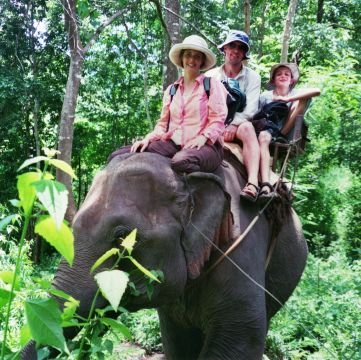
Next up on our busy schedule was elephant riding. We'd done this before near Kanchanaburi and weren't really looking forward to it - the elephants never seemed very happy (sometimes the mahouts hit them with wooden sticks) and sitting on the platform behind the elephant's head is excruciatingly uncomfortable. If you lean back the iron pole holding the platform together digs painfully into your back, your bum get sore and it's hard to find somewhere to dangle your legs. But Karen had learned her lesson, so this time she simply sat directly on the elephant's head. "This is way more comfortable," she said. That also meant there was more room for Scott and me on the wooden platform so we were also happier.
The elephants plodded through the jungle for a couple of kilometres, eventually arriving at another hill tribe village. This one was inhabited by the Karen tribe (who were originally from Myanmar), and appeared to be a fair bit more prosperous than the previous one we'd visited. A notable feature of this village was that the huts were roofed with leaves from teak trees; these are completely waterproof and last about two years before having to be replaced completely.
We finished off the day with a hike through the jungle to the Mae Sapok Waterfall, a torrent of water that plunged into a deep pool in a clearing. It was beautiful but it was late afternoon and the pool was in deep shadow, the water icy cold. After a long and tiring day we were quite relieved to doze in the minibus on the drive back to Chiang Mai.
Back in Chiang Mai that evening we walked around the crowded night market in the street, where almost anything you can think of is for sale and all prices are negotiable. After protracted haggling we bought Scott a very nice "knock-off" watch then had delicious pancakes from a street vendor for supper.
[Wednesday 28 June : Chiang Mai, Thailand] Our second trip from Chiang Mai began with a brief stop at some hot springs nearby. The water is way too hot to swim in - it bubbles and steams in wells and is used by locals to boil eggs. Then we visited two more hill tribe villages; the Akha tribe, who originally come from Tibet, were poverty-stricken and pathetic and just stood around listlessly waiting for us to give them money. I felt very sorry for them but what could we do? Surely there must be some way for these marginalized people to be incorporated gainfully into Thai society? I suppose there are poor people and squatters everywhere, but it definitely seems to me that the Thai government is failing its rural hill dwellers ... a little like the gypsies in Europe, I guess.
The Yao tribe village was much more organized. Originally from China, the Yao have very distinctive and colourful traditional headgear and appeared to have adapted well to life in Thailand. Their huts were sturdily constructed and well maintained and there was none of the desperation that seemed so palpable in some of the other villages we'd been to.
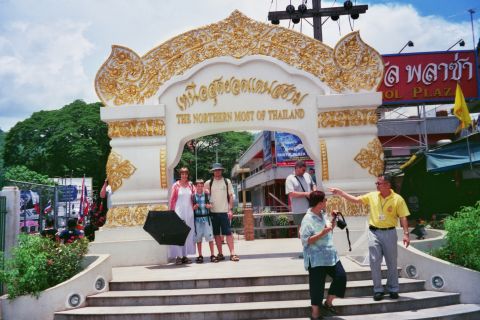
After that we sat in the mini bus for a long drive north to Mae Sae, the northernmost town in Thailand and right on the border with Myanmar. Mae Sae is favoured by backpackers for doing a "visa run" - this involves a quick trip over the border to Tachileik in Myanmar and then back again twenty minutes later, thus securing a further 30 to 90 days of legal residence (depending on nationality) in Thailand. Mae Sae is probably the easiest town in Thailand in which to do this, as the border post is at the end of the main street and you can simply walk over. Of course, the draconian rules set by the military government of Myanmar make it quite difficult to get into Myanmar for any extended period, but day trips (with severe restrictions on how far from the border you can go) are usually allowed.
In 2008 "visa run" activity was drastically curtailed by the Thai government when it was announced that if you enter Thailand via a land border you would only be permitted to stay for 15 days without a visa, not 30 days as was previously the case. However, 30 days are still allowed if you enter the country by air or if you obtain a visa prior to arrival.
Not far from Mae Sae is the Golden Triangle, the point where the borders of Myanmar, Laos and Thailand converge. It is here, in the mountains at the confluence of the Ruak and Mekong Rivers, that a huge portion of the world's heroin is produced (Afghanistan recently became the top illicit drug producer in the world, relegating the Golden Triangle to the number two position). Most of the opium is grown by poverty-stricken people in Myanmar, where the military government has shown no inclination to act against the all-powerful drug lords - the drug lords simply pay off the poorly-paid and corrupt police investigators and continue to live with impunity in their billion dollar mansions. The real losers (apart from the many drug addicts round the world whose habit is kept alive) are the rural peasants who actually cultivate the opium poppies - they are paid a pittance for their efforts while the drug lords rake in millions. But that's the nature of the drug production "business" all over the world ...
Lunch was the typical procedure you get on these day tours. We stopped at an isolated cluster of buildings that looked totally deserted and then were marched through the showroom of a place selling high quality (and very expensive) jewellery and artifacts. Immaculately dressed and perfectly made-up ladies were in attendance behind every counter, beckoning us to inspect the wares they had for sale. Nobody else was around, just the six or seven Western tourists from our minibus, the sales ladies and the bus driver and guide ... who disappeared very quickly once they'd led us into the showroom. We looked at the stuff for sale but by now we were quite retail-hardened and managed to tear ourselves away without difficulty.

Next door was the restaurant, and there we found the driver and guide tucking into their lunch. We sat down and enjoyed another excellent repast, watching with interest as the other Westerners in our group slowly wandered in. I couldn't tell if any of them had succumbed to the wiles of the sales ladies but I'm guessing at least one or two probably had. "Hard sell", "scam" and "Thailand" should all be listed as synonyms in any standard English dictionary, I'm afraid.
After lunch we drove a short distance to a parking area next to the Mekong River, where we were given life jackets and climbed aboard long-tail boats. The river is so wide you almost can't see the other side so we puttered across the choppy water for several minutes before nosing up to a ramshackle wooden dock.
"This is Don Sao," announced our guide. "It is an island but part of Laos, not Thailand. We visit for an hour."
I was puzzled. "But we need a visa for Laos," I said. "How can we go ashore here?"
"Don Sao island has a special dispensation from Laos government - Westerners can visit without a visa. But you can't stay the night." The guide waved his arms. "Walk around, explore, take photos and meet back at boats in one hour."
That was interesting, and having experienced the workings of the tourist industry in Thailand I was fairly suspicious of some kind of scam. But it turns out that Don Sao is indeed a Laotian island in the Mekong River, and tourists are permitted to make day visits without a visa. There is no passport control or immigration office on the island and our passports were certainly not checked before we got into the boat on the Thai side of the river, so for all intents and purposes we were still in Thailand. But once we'd stepped off the boat onto the island we did spot a guy in a creased and stained uniform behind a desk, trying (and failing miserably) to look official. He stamped our passports and, of course, wanted a few Bahts (not Laos Kip) to do this. The stamp was very obviously a fake - it had no date of entry or any kind of government seal but was simply the words "I'm here, Don Sao Laos, Golden Triangle."
A similar, but far more organized arrangement is in place at the Myanmar border near Mae Sae - Westerners can cross into Myanmar there without a visa but are not permitted to go any further into the country than the border town of Tachileik. There are proper border controls and if you don't have a visa the Myanmar immigration people will keep your passport and only hand it back to you when you exit the country into Thailand again.
There's nothing on Don Sao island except bars, restaurants, tourist trinkets and stalls selling the local speciality - bottles of whiskey containing a snake preserved in the alcohol. To make this gruesome drink, locals drown a cobra in rice wine then leave it to ferment for a couple of months. Snake whiskey is regarded as a strong aphrodisiac and pain reliever (and can apparently cure anything from hair loss to depression to low energy, very possibly fix any financial difficulties you may have and find you an attractive husband or wife) but we declined the many invitations we had from hard-sell touts to purchase their drinks. There is no village or houses on the island, just locals (Lao, Thai or Chinese, we couldn't tell) selling stuff to the multitudes of Western tourists who get ferried there in long-tail boats from Thailand.
When our hour on the island was up we puttered back across the river to Thailand and drove a short distance to the ancient city of Chiang Saen. Chiang Saen is reputedly the oldest city in Thailand and was originally founded in about 545 AD by Chinese immigrants from Yunnan province. No reliable records exist until about 1325 when Thai king Mengrai established himself in northern Thailand. There's not much to see - today the city is just ruins, piles of stones slowly being overtaken by the ever-encroaching tropical vegetation. We walked around for a while before climbing back into the minibus for the long drive back to Chiang Mai.
[Thursday 29 June : Chiang Mai, Thailand] Walked around Chiang Mai (a very nice, relaxed city, with loads of book shops containing English-language books) then caught the overnight train south to Bangkok - no compartments in second class, everybody sleeps in bunks with only a curtain for privacy. The bunks are laid out parallel to the direction of travel, down the sides of the train, with a passage in the middle. Unfortunately, because we booked our tickets so late we could not get the much sought-after bottom bunks, which are quite a lot bigger. We each had a top bunk, which was fine for Scott but I found it quite cramped - they're not made for tall Westerners, but rather for short Thais.
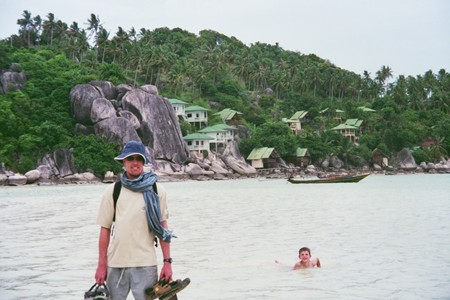
Thai Railways uses metre gauge tracks (1000 mm), which are quite a lot narrower than standard gauge (1435 mm) or even Cape gauge (1067 mm). Trains in Thailand are thus not very wide, necessitating bunks on sleeper coaches being laid out along the sides of the train, not at right-angles.
[Friday 30 June : Chumphon, Thailand] Arrived in Bangkok early and immediately caught a second class "sitter" train south to Chumphon, the nearest mainland town to the east coast island of Ko Tao. We didn't make it in time to get the last ferry to the island that evening so we had to spend the night in Chumphon. On the way south the train hit a motorcyclist and had to stop, reverse, pick up the injured driver (a woman) and take her to hospital in the next town.
[Saturday 1 July : Ko Tao, Thailand] Caught the 7 AM ferry to Ko Tao, the smallest and most northerly of three islands off the east coast in the Gulf of Thailand. It was a rough trip of about three hours, with lots of people looking very green - I didn't feel too good myself. On Ko Tao we booked into the Taa Toh Lagoon resort on the south-west coast, an idyllic spot on a fabulous beach with palm trees, warm water, a great view from our balcony and (unfortunately) lots of rain. I guess we're in the tropics, what can you expect ...
[Sunday 2 July : Ko Tao, Thailand] Ko Tao ("Turtle Island" in English) is pretty small, only about 21 square kilometres in size. We walked round the west coast of the island from our beach hut via a very rough jungle trail to Mae Haad, the largest village on the island and where the ferry had docked the previous day. Mae Haad is a ramshackle sort of place, with dirt roads full of mud and puddles from the rain and plenty of restaurants and souvenir shops. We had lunch in Mae Haad, looked at the shops then walked back to our resort on the road, dodging the multitude of motorcycles and scooters that buzz around all the time. It poured with rain most of the day, but was still blazing hot and we swam later on while it was raining.
[Monday 3 July : Ko Tao, Thailand] Moved to a different resort, just up the beach from the place we'd stayed in for two days - much cheaper and a better location as well. Because of the huge boulders at the edge of the beach we had to get to this new place by carrying our backpacks and gear through the sea, in waist-deep water; otherwise it would have meant a long trek round on the road that skirts the forested hill behind the resort. After settling in we lazed on the beach for the rest of the day, in lukewarm water, knee-deep and crystal clear.
[Tuesday 4 July : Ko Tao, Thailand] We rented two motor-scooters and explored the whole island, from north to south and east to west. There is an entire whale skeleton mounted on rocks at a resort in the north. On the north-west coast we found a resort devoted to meditation, from which there is a fabulous view across the sea to Nangyuan island and the twin rocks that are connected to Nangyuan via a narrow spit of sand. Ko Nangyuan is very near Ko Tao and it looks as though you could easily swim to it, but apparently the currents in the narrow channel between the two islands are extremely strong and swimming is not recommended. There is only one resort on Ko Nangyuan, aimed mostly at well-heeled divers who are prepared to pay their wildly inflated prices. We headed south again and went swimming at Sairee Beach on the west coast (Sairee is the main beach on Ko Tao and is several kilometres long), where we came across the huge rock known as "King Rama V Rock."
We finished our scooter tour of the island with a long swim at Aow Leauk, a fabulous, secluded beach on the east coast. Unlike most of the other beaches we visited, Aow Leauk beach has deep water and big swells rolling in from the ocean, but the water was still amazingly warm - you could stay in for hours with no discomfort at all. We left as the sun was setting and pootled back to our beach hut.
[Wednesday 5 July : Ko Tao, Thailand] We rented a 3-person kayak and snorkelling equipment and paddled around the small bays on the south coast, swimming and snorkelling in the clear water. We saw tons of fish, including a puffer fish (very poisonous - the toxin of the puffer fish was used in the past by witchdoctors in Haiti to turn people into "zombies").
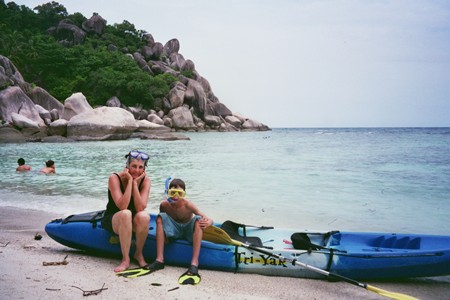
[Thursday 6 July : Bangkok, Thailand] Our beach holiday break was over, and at 2 PM we began a long, hard journey from the island of Ko Tao to Phnom Penh in Cambodia. This entailed
The taxi ride through the early-morning darkness of Bangkok was a crazy, white-knuckle experience, leaving us all with weak knees and trembling fingers - I guess the driver was getting back at us for negotiating too hard before we agreed on a price.
We had quite a long wait at the airport before our early morning flight to Phnom Penh in Cambodia. It was on Air Asia, a budget airline with no tickets, no frills and bookings only via the internet. However, it was cheap, pleasant and on time so we had no complaints.
[Friday 7 July : Phnom Penh, Cambodia] We landed at Phnom Penh airport in mid-morning, and after negotiating customs and immigration we took a taxi into the city. We trudged around in the heat, looked at several guest houses and eventually found a great room at a place called the Swiss Guesthouse for six US Dollars a night. Completely knackered, we had a shower and nap before venturing out again [Aside : Cambodia's currency (the Riel) is worthless and everything is priced in US Dollars - even the ATMs dispense dollars. There are no coins of any kind and about 4000 Riels to the Dollar].
Our first port of call was the Royal Palace, the official residence of the king of Cambodia. The palace is a huge estate comprising many buildings, temples and stupas, the most impressive of which is undoubtedly the Silver Pagoda. The Silver Pagoda is so named because it has a floor made entirely of several thousand solid silver tiles. It also contains a diamond-studded Buddha and is consequently the most visited place in the whole of Phnom Penh. After leaving the Royal Palace we strolled along the Tonle Sap River, near the confluence with the Mekong River, and had a look at the Cambodia-Vietnam Friendship monument. Lunch was at a local street-side restaurant and cost the princely sum of $1-50 for the three of us TOGETHER. It was cheap but we knew it would be good - the place was packed with locals (always a good sign) and the food was delicious.
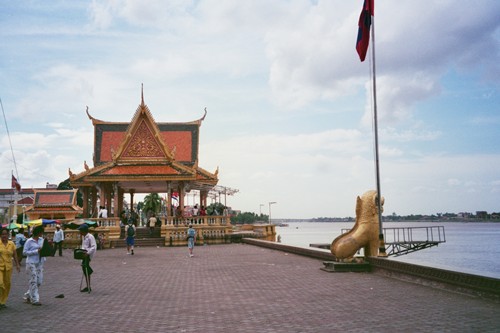
Buying soft drinks from a street vendor in Phnom Penh gave us another insight into the desperate poverty of the Cambodian people - the vendor carefully poured each drink into a separate plastic bag and gave us the bags plus three straws. Then the empty glass soft drink bottles were carefully stored in a crate, either for later reuse or to get a refund, we were unable to establish. This seemed to be a fairly common practice in Cambodia, and not only for soft drinks - petrol is sold from roadside stands in a similar way, except that disposable plastic bottles are used, not plastic bags.
At supper that night the brutal reality of life in post-Khmer Rouge Cambodia was made shockingly obvious. A block away from our guest house was an open square, empty during the day, but which was transformed into a teeming conglomeration of makeshift restaurants at night. Tables, chairs, tablecloths, cutlery, stoves, cooking utensils and portable refrigerators suddenly appeared, bringing a rather dead area of open tarmac to life with activity, food and laughter. We walked there for supper, and chose one of the pop-up restaurants at random - they all seemed to have identical menus. These makeshift places are fast, so within minutes we were eating; unsurprizingly, the food was fantastic, fresh and flavourful. We saw a few other Westerners also eating, but most of the diners were locals.
Half way through our meal I noticed a group of street children squatting on the tar a short distance from our table. They ranged in age from about five to fifteen and sat in silence without moving, their hollow eyes hungrily watching us. They did not approach us or make any attempt to beg, just sat watching. Glancing around I saw that the other tables where Westerners were sitting also had a retinue of observing children. We debated what to do, and hadn't yet decided when Karen put her chop sticks down and pushed her plate away, some rice still uneaten. Instantly one child darted forward holding a plastic bag, and in one expert movement she upended Karen's plate into the bag, ensuring that not one grain of rice fell to the ground. At no time did she threaten us or try to intimidate us into giving her food - she simply took the food that wasn't eaten and put the clean plate back onto the table. The restaurant people made no attempt to intervene, so this was obviously a normal and expected occurrence.
Finally we got it - the children were starving and wanted whatever food was left over. They had worked out that if they took uneaten food from plates after people had had enough, did not steal the plates and did not hassle the diners, the restaurant owners would not stop them or chase them away. Incredible ... so Scott and I both left some food behind, and it too was cleaned off our plates into plastic bags. No words were exchanged and the children vanished into the night once they realized there were no further pickings available from our table. That episode has to be one of the saddest things I've ever experienced in all my years of travel - children reduced to such a pitiful state of hunger that they have to scrape left over food off diners' plates at restaurants. How the Khmer Rouge leaders who systematically destroyed Cambodia during the utter madness of their four years of rule managed to get away unpunished will forever remain one of the mysteries of the twentieth century.

[Saturday 8 July : Phnom Penh, Cambodia] We spent the morning at the Tuol Sleng Genocide museum, a moving place that documents the unbelievable atrocities committed by the Khmer Rouge regime under Pol Pot between 1975 and 1979. It is estimated that nearly 2 million people in Cambodia were brutally murdered during that time, many of them at the Killing Fields just outside of Phnom Penh. Another 1 million or so died from starvation directly or indirectly because of the insane Khmer Rouge policy of turning Cambodia into an agrarian nation of peasants (which effectively destroyed the country's economy). Proportionally, this is the worst example of genocide in human history, worse even than Hitler in Germany, Stalin in the Soviet Union or Milosevic in Yugoslavia, as the population of the entire country at the time was only about 9 or 10 million. One of the most disturbing aspects of this tragic period in Cambodian history is that NOT ONE of the Khmer Rouge leaders was ever brought to trial for crimes against humanity, including Pol Pot himself. How is that possible?
Pol Pot, whose real name was Saloth Sar (and known as "Brother Number 1" by the Khmer Rouge leadership), was never captured or arrested. He died in mysterious circumstances in April 1998 in the little village of Anlong Veng in the far north of Cambodia, not far from the Thai border. By that time the Khmer Rouge movement had become insignificant and irrelevant, and after Pol Pot's death it disappeared completely.
We had lunch at a typical restaurant catering for Westerners - smart, clean and air-conditioned but with overpriced, mediocre food and terrible service. From that point on we resolved to eat only at the local street-side restaurants, which invariably served delicious food in an authentic setting. On the way back to our guest house we passed the massive Independence Monument, which contains multiple nagas (multi-headed serpents).
[Sunday 9 July : Siem Reap, Cambodia] A short walk through the broken streets of Phnom Penh brought us to the bus station, where we boarded an early bus to Siem Reap in the north-west of Cambodia. Siem Reap is the nearest town to the fabled ruins of Angkor; the scrum of touts at the Siem Reap bus station wanting to give us lifts, guide us or get us accommodation had to be seen to be believed. We managed to negotiate (fight?) our way through the crowd and got a very nice room at Popular Guest House for the next three nights at only ten US dollars a night. Popular Guest House (which was subsequently improved and renamed to the Popular Boutique Hotel) was centrally located and had a shady open-air rooftop restaurant - a great spot to relax and escape from the oppressive heat.
[Monday 10 July : Siem Reap, Cambodia] Got up at 4:30 AM so that we could get to Angkor Wat in time for sunrise, which turned out to be disappointing as it was cloudy. Angkor Wat is the largest religious building in the world, and the ruins are truly magnificent - no matter what you've read or been told about Angkor Wat, the majesty and grandeur of the place cannot fail to inspire you.
We clambered around Angkor Wat for a few hours before going on to visit many of the ruins and temples in the Angkor Thom complex, such as Bayon (which has no less than 216 carved faces of the Khmer god Avalokiteshvara on 54 square pillars), Baphuon (a huge pile of stones and rubble which is painstakingly being put back together by archaeologists), the Terrace of Elephants and the Terrace of the Leper King (which has an excavated trench showing hundreds of detailed, evil-looking carvings).
After that we rode to Ta Prohm and some other lesser sights in the huge Angkor complex. Ta Prohm has been almost completely overrun by jungle, to the extent that huge trees are actually growing out of the walls; it was used as one of the sets in the movie Lara Croft : Tomb Raider (which starred Angelina Jolie as a kind of female Indiana Jones). Our last stop was Preah Khan, a ruin which is surmised to have been an ancient Buddhist school or university. Near Preah Khan is a strange building that seems totally out of place in Angkor; it has circular pillars and looks Greek, whereas everything else in Angkor is square or has squared corners. Very odd.
[Tuesday 11 July : Siem Reap, Cambodia] Took a tuk-tuk (trailer pulled by a motorcycle) to some of the outlying ruins of Angkor. First we went to Banteay Srei, a very ruined temple with hundreds of incredibly intricate and elaborate stone carvings, then we hiked for 45 minutes through the jungle to Kbal Spean (riverbed carvings and lingas, most of which have been looted). We re-visited Angkor Wat itself late in the afternoon; Angkor Wat is so impressive it needs at least two visits to appreciate it fully. Even then you can only begin to grasp the scale of the achievement when you've explored each of the three symmetric tiers several times. Our last stop was Phnom Bakheng, which required a very steep climb, but unfortunately the fabulous sunset view from there was ruined by banks of low cloud.
[Wednesday 12 July : Battambang, Cambodia] We checked out of our guest house early and went by minibus to the boat dock that serves Siem Reap, a ramshackle collection of jetties on the Tonle Sap River a few kilometres outside town. The place was a mess of mud, rubbish, beggars and derelict boats, and the boat we finally boarded did not fill us with any confidence or enthusiasm. We were bound for Battambang, the second-largest city in Cambodia, and had thought that getting there by boat would be a novel and interesting experience. We were proved right, but not in the way we imagined ...
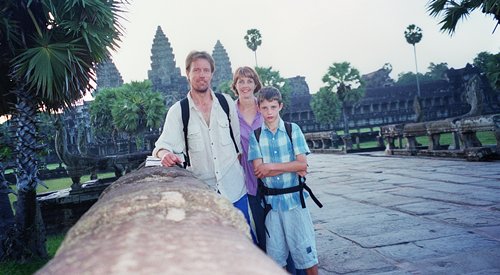
Our boat chugged away at about 7 AM, negotiated the river settlements near Siem Reap for a short distance then headed out into the vast Tonle Sap Lake. Tonle Sap Lake is huge, the largest body of fresh water in the whole of South-East Asia. At the end of the dry season it covers about 2 500 square kilometres, but during the rainy season the lake floods an area of more than 10 000 square kilometres. The water level rises so fast that it actually reverses the direction of flow of the Tonle Sap River (which normally drains the lake)! At times when our boat was crossing the lake it appeared as if we were in the middle of the ocean - no land was visible in any direction. But eventually we reached the other side where the boat nosed into the broad and muddy Sangker River (Stung Sangker).
The whole trip was a truly nerve-sapping ten hour ordeal in alternately torrential rain showers and blazing heat. The boat broke down several times, collided with the bank, felt like it was going to capsize any moment and filled with water faster than the pumps could handle. But despite the decrepitude of our transportation, the journey down the river provided a fascinating insight into a culture with a very different lifestyle, because for many kilometres in the Tonle Sap lake and along the Sangker River there are floating villages where people spend their lives living on the water - houses, shops, restaurants and even schools are on boats. Rather than driving or walking to the shops, people go by boat. Children go to school in small canoes. On occasion there were water-based traffic jams, with a profusion of small boats criss-crossing the river in every direction, nimbly avoiding our lumbering diesel behemoth. These floating villages are populated mostly by stateless ethnic Vietnamese, displaced from their homeland by the years of conflict in the region and eking out a fragile existence from the water.
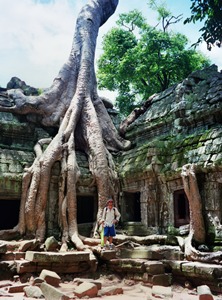
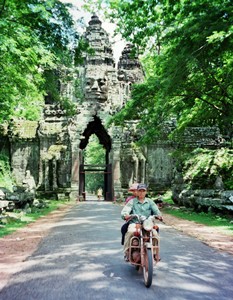
The boat we were on was like a bus that never stopped, because quite frequently as we chugged along small canoes would dart out from the mass of connected floating houses and meet our boat while it was still moving; somebody would climb aboard with a suitcase and the canoe would paddle back, the passenger safely aboard the "bus." This continued for much of the journey down the river, until there weren't enough seats for all the passengers on the boat - many of those who boarded later on had to stand all the way to Battambang or sit on the roof out in the open, where there was no shelter from the searing tropical sun.
When we finally docked near Battambang we had to clamber onto the river bank via a rickety gangplank and squelch through thick mud to a dirt road, where minibus taxis were waiting to take us into town. But the ordeal of the boat trip ended on a happy note when we checked into a very comfortable room at the Royal Hotel for the next two nights; a refreshing shower and an excellent dinner at the White Rose restaurant in Battambang rounded off a long, hard day.
[Thursday 13 July : Battambang, Cambodia] Battambang is a bit of dilapidated place - broken pavements, poverty, squalor and filth. The city is a fraction of the size of Phnom Penh (luckily with none of the capital's frenetic traffic) and sits alongside the tranquil Sangker River, slumbering and somnolent in the heat. It is hard even to find a restaurant here, and when you do you get besieged by street children begging for food. However, we strolled around and saw what little there is to see - the central market, some crumbling old French architecture, the broad and muddy Sangker River and a derelict train station that sees ONE train a WEEK (from Phnom Penh). In fact this is the only passenger train still running in the entire country; the rails are so crooked it's a wonder this sole surviving train ever makes it that far.
Update 1 : By 2009 this train had been terminated, and until 2016 there were absolutely no operational trains in Cambodia at all. However, during this period a large number of informal "bamboo trains" zipped up and down the abandoned railway tracks; see here for a fascinating story about these home-made trains.
Update 2 : In April 2016 a new train service was inaugurated on the rehabilitated Phnom Penh-Kampot-Sihanoukville route, and work continues on various other railway lines in the country (including an international connection with Thailand at the Poipet-Aranya Prathet border).
Update 3 : In 2018 the line from Battambang to Poipet via Sisophon was re-opened (this route had been closed since 1973), but the short distance across the border from Poipet to the Thai railway terminus at Aranya Prathet remained closed. This cross-border connection was finally completed and inaugurated in April 2019. It is now possible, for the first time ever, to take a train from Bangkok all the way to Phnom Penh.
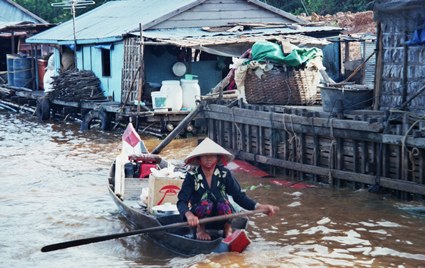
[Friday 14 July : Bangkok, Thailand] Took a bus from Battambang north-west via Sisophon to Poipet on the Cambodia-Thailand border, crossed into Thailand on foot and then caught a Thai minibus west via Aranya Prathet to Bangkok for our last night in Thailand. The road west from Sisophon to Poipet in Cambodia has to be seen to be believed - huge potholes, flooding, mud, trucks stuck all over the place, cars crashed; a hair-raising, kidney-rattling drive. The gulf between the relative wealth and prosperity of Thailand compared with the abject poverty of Cambodia is sad and shocking; decades of military rule, civil war, communist Khmer Rouge madness, Vietnamese occupation, American bombing, political instability and ongoing corruption have left Cambodia in a tragically desperate state that will take many generations to rectify. Even today (July 2006) the democratically elected government includes people who were members of the former Khmer Rouge regime, and who have never been called to account for the unspeakable atrocities they perpetrated.
The bus got into Bangkok at about 7 PM that night. I managed to persuade the driver to drop us near the hotel in which we would be staying, so we didn't stay on the bus all the way to the terminus at Khao San road and then have to haggle with taxi drivers in the dark. It was just a short walk to the hotel, where we arrived dishevelled, haggard and stinking from days of travel; the receptionist checked us in and ushered us out of the hotel's elegant reception area in double quick time before we could offend any of their more well-heeled guests [Aside : This was the third night of the three nights' free accommodation we received with our air tickets].
[Saturday 15 July : Kuala Lumpur, Malaysia] Our last day in Thailand ... we walked around Bangkok and did some last-minute shopping to get rid of our few remaining Thai Bahts, then took our hotel's courtesy bus to the airport and caught our plane to Kuala Lumpur in Malaysia, a short trip of a couple of hours. We had a five hour layover at Kuala Lumpur International Airport, from 8 PM to 1 AM.
[Sunday 16 July 2006 : Cape Town, South Africa] Our connecting flight from Kuala Lumpur to South Africa left at 1 AM, and we arrived in Cape Town (after a tedious stop in Johannesburg) at about 9 AM after a few time zone changes. After the 35+ degree temperatures we'd been experiencing, the cold weather in South Africa was tough to adjust to. And thus ended our South-East Asia adventure ... next stop Italy in 2007 (for Karen) and the Middle East in 2008 (for all three of us).